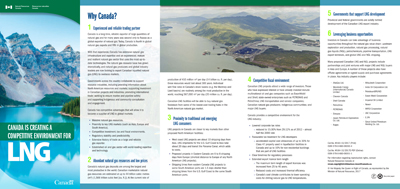Liquefied Natural Gas (LNG) is natural gas in its liquid state. When natural gas is chilled to a temperature of about minus 160° C (minus 260° F) at atmospheric pressure, it becomes a clear, colourless and odourless liquid.
LNG is non-corrosive and non-toxic. Due to its extreme cold nature, LNG can flash freeze any flesh it touches if released. Consequently, it must be carefully manufactured and stored.
The liquefaction process removes water, oxygen, carbon dioxide and sulfur compounds contained in the natural gas. This results in an LNG composition of mostly methane with small amounts of other hydrocarbons and nitrogen.
As a liquid, natural gas is reduced to 1/600th of its original volume. Consequently, it is feasible and economical to transport in specially designed ocean tankers to distant markets otherwise inaccessible by pipeline. Once received, the LNG goes into storage tanks, is re-gasified, and delivered to markets.
LNG supply chain
The LNG supply chain (as illustrated in the following figure) consists of several interconnected elements.

Text version - LNG Supply Chain
Interconnected elements include the gas field, liquefaction plant, LNG storage tanks, LNG tanker, vaporizers, and pipeline systems.
- Natural gas is extracted from basins and transported by pipeline to liquefaction plants. Natural gas is liquefied and stored there. Liquefaction plants are built at marine terminals so the LNG can be loaded onto special tankers for transport overseas. For domestic use, liquefaction facilities may also be located inland, with LNG transported to destination markets by long-haul trucks.
- After tankers or trucks deliver the LNG cargo to import or domestic receiving terminals, the LNG is stored, re-gasified and injected into pipeline systems for delivery to end users.
Regulations and permitting
The federal and provincial governments are involved in the regulatory and permitting processes that are required to authorize building and operating LNG facilities.
A project must undergo impact or environmental assessments. Companies submit a project description, which is a document that details many aspects of the project, including anticipated impacts to air, land, water and climate, along with consultations done and planned with Indigenous communities and other stakeholders.
The Impact Assessment Agency of Canada(IAAC) conducts an impact assessment for projects subject to federal regulation. Its impact assessment reportFootnote 1 is submitted to the Minister of Environment and Climate Change for final decision on project approval. Provincial regulators conduct independent environmental assessments of proposed projects, and may substitute for federal processes where agreements exist between provincial and federal authorities to do so.
The company must also apply to the Canada Energy Regulator (CER) for an export license.Footnote 2 A licence may be requested for up to 40 years of LNG exports, and would list the volume of natural gas to be export, among other factors. After its review, the CER approves or rejects the export licence application, which is then forwarded to the Minister of Energy and Natural Resources in the form of a recommendation for decision.
Most of the proposed Canadian LNG export facilities require new pipelines or the expansion of existing pipelines to supply the facilities. If proposed as a separate project, the pipeline may require a separate environmental or impact assessment, distinct from the LNG project.
Individual provincial and territories regulate projects that are contained within their borders, but the federal government regulates pipelines that cross provincial or international borders.Footnote 3
Other federal, provincial, territorial, and municipal approvals or permits may be required before and during construction and operation stages.
LNG Facilities and Safety Regulations
LNG facilities are classified as industrial sites and must meet all federal, provincial territorial, and municipal standards, codes and safety regulations. These regulations are constantly updated to ensure that the health, safety and security of the environment and Canadian public are protected. The Canadian Standards Association (CSA) has a specific standard for LNG production, storage and handling (CSA Standard CAN/CSA Z276-01). This standard establishes essential requirements for the design, installation and safe operation of LNG facilities.
Canadian LNG Projects
Canada has four LNG plants currently serving the domestic market, in addition to LNG import facilities: in Saint John, New Brunswick, and at the Port of Hamilton, Ontario.
At present, there are several proposals for LNG export facilities in Canada. Consult Canadian LNG Projects for more information on the status of Canadian projects.
Related Links
These websites provide useful background information on LNG and LNG regulatory processes in Canada.
